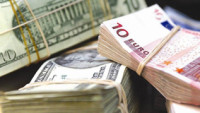 The ingredients for more rangebound trading are all there, especially given an uninspiring US data calendar and no impact of Chinese news. However, the ECB’s negotiated wage growth indicator is a key test for the euro. We think a decline in salary pressure can help a further unwinding of EUR longs. In Sweden, the Riksbank’s dovish turn looks a bit premature
The ingredients for more rangebound trading are all there, especially given an uninspiring US data calendar and no impact of Chinese news. However, the ECB’s negotiated wage growth indicator is a key test for the euro. We think a decline in salary pressure can help a further unwinding of EUR longs. In Sweden, the Riksbank’s dovish turn looks a bit premature
USD: Markets Unimpressed With China’s Rate Cut
US markets re-open today after an uneventful Monday for global markets. US stock indices’ futures are trading on the soft side, and the US calendar is unlikely to be a big driver today. January’s Leading Index is the only release scheduled for the day, and things will be rather quiet on the US macro front until the FOMC minutes are published tomorrow evening.
China is once again the focus this morning as banks reduced their five-year loan prime rates by a record 25bp to 3.95% overnight, the first move of this kind since June. This kind of monetary easing has a generally higher impact on the property market, but once again markets have shown little enthusiasm. CNH is bucking the modestly stronger USD momentum this morning, but gains are very limited. As mentioned in yesterday’s FX Daily, news of strong travel numbers during the Chinese New Year also generated a modest positive impact on markets, confirming that expectations of a recovery in China’s growth sentiment will be gradual at best.
Latest positioning data from CFTC show the dollar is generally oversold against EM and overbought against G10 currencies among speculators. That clearly mirrors markets’ favouritism for carry-attractive currencies and signals that the dollar remains too expensive to be shorted consistently against lower-yielding developed currencies.
That said, the view that the US data will turn at some point, the Federal Reserve will cut, and the dollar will decline remains a consensus one (and often translates into selling USD rallies). We favour a strong dollar in the near term as US data remains supportive, but this looks increasingly to be the perfect recipe for range-bound trading. In DXY terms, 104/105 may hold as a range in the short run.
EUR: Wage Growth Below 4.5% Should Hit the Euro
Things aren’t as quiet in the eurozone as in the US today. The European Central Bank will publish the eurozone-wide indicator of negotiated wage rates for the fourth quarter, which at this point is one of the most important data input for the Governing Council. The latest ECB meeting put wage growth even more at the centre of the policy discussion, pointing to how rate cuts are to be ruled out unless negotiated salaries move convincingly in the right direction.
There is no published consensus for the release. We believe our economics team’s call for a 4.4-4.5% year-on-year read is moderately lower than expectations. This wage indicator had been on a steady rise since mid-2022, and a decline, even if contained, should be welcome by the ECB. It will be up to the 2024 first quarter GDP print (which includes detailed wage information) in April and the negotiated wage indicator in May to greenlight or redlight a rate cut in June, given the second quarter GDP figures are published after the June meeting.
The same speculative positioning data mentioned above tell us that the euro is an outlier in the G10 space, being moderately overbought (+7% of open interest) against the dollar despite its widely negative rate differential. Watch for some positioning adjustment on the downside today in EUR/USD, should the ECB wage growth come in below 4.5%. Still, we would not be surprised to see good support at 1.0700.
SEK: Riksbank’s Dovish Game Looks Risky
Sweden’s Prospera inflation expectations surveys this morning did not have any market impact, coming broadly in line with the recent trend. One-year CPIF expectations declined further from 2.0% to 1.9% in the past month, 2-year expectations held at 1.9% and 5-year expectations (here is a small surprise) ticked higher from 2.0% to 2.1%.
Yesterday, the inflation report showed CPIF rising more than expected (from 2.3% to 3.3% YoY), even though core inflation declined in line with consensus from 5.3% to 4.4%. The Riksbank recently turned dovish in its narrative, even signalling that rates can be cut in the first half of the year. The larger-than-expected increase in headline CPIF suggests optimism about disinflation may have been premature.
Crucially, we suspect that the easing guidance offered in February can end up being counterproductive. That is because – as admitted by the Riksbank itself – avoiding a weakening of the krona remains crucial for the inflation battle, but at the same time the early easing guidance (along with the end of FX sales) puts the krona in a fragile spot if sentiment turns negative for high-beta FX. We think EUR/SEK can trade higher from these levels in the short-term, but the Riksbank may well be ready to redeploy FX sales should SEK weaken too much. Our medium-term view for the pair is a break below 11.00, but once again we suspect the Riksbank’s monetary policy communication is adding hurdles to the SEK recovery path.
CAD: Disinflation Stall
Canada releases inflation figures for January today, and consensus is centred for a stabilisation in the core measures (trim and median) at the 3.6% YoY level. Headline CPI is seen ticking lower from 3.4% to 3.3% YoY, with a 0.4% month-on-month increase after December’s encouraging -0.3% MoM.
The expected slowdown in the disinflation process is in line with developments in the US and other major countries, and not too concerning for the Bank of Canada which estimates headline inflation at 3.2% in the first quarter of the year. Nevertheless, a tight labour market and the timing of the first Fed rate cut being pushed back means the BoC will likely opt for patience over more dovish guidance in upcoming communication. That is, unless today’s CPI numbers surprise markedly on the downside.
USD/CAD can find a bit more support in the coming weeks as we see USD staying strong and risk sentiment fragile. A return to last week’s 1.3585 highs seems appropriate for now. However, we still expect a decline in USD rates to unlock downside potential for the pair in the second half of the year, even with the BoC cutting at the same time as the Fed.












